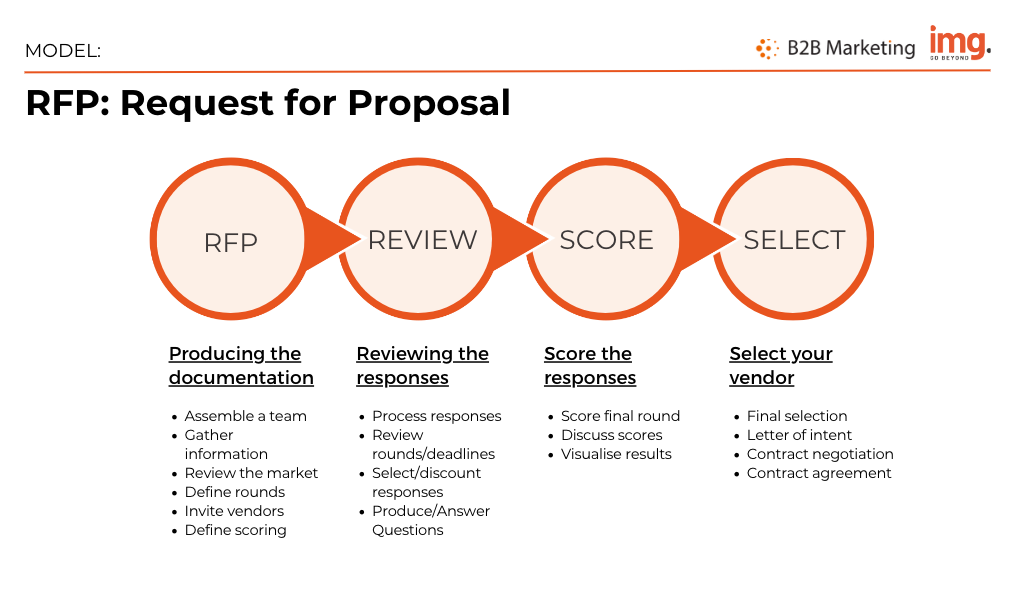The secret to successful vendor selection for your business: The RFP model
How to select a vendor using an RFP
Bringing technology and tech suppliers into your organisation is unavoidable, but you must be sure you select the right tool for your business and that is best done using an RFP process. Often a complex and lengthy process, this model shows you the key elements to consider when selecting a vendor.
There isn’t a single role in the marketing landscape that doesn’t use some sort of technology. And, since marketing automation is growing functionality arms and legs, there are now many more options for businesses to pick (over 11,000 at the last count) [1].
How can you be sure to pick the right tool or the right vendor or partner to work with when you are shelling out a chunk of your budget on technology?
The simple answer is a solid RFP process.
For those who are unfamiliar, RFP stands for request for proposal or sometimes request for purchase. It is a tool used to score and select vendors that fit your requirements. But beware, creating and responding to RFPs can easily become complex, cumbersome and time-consuming.
Not every purchase needs one (despite what you might be told) and they should only be used when a company is spending a large amount of money on a significant piece of technology. They’re best used to carry out a thorough and objective comparison and assessment of multiple vendors.
For this purpose, let’s assume you fit those criteria and do want to use an RFP process to select a tool.

I would suggest there are 4 stages to consider:
1. RFP START-UP
To kick this off you need to assemble a team. I would consider that being more than one person because you need an objective view of this process and that means it may demand some challenge. There is normally a project manager involved as this process in its nature is a project that should be completed in a defined timeframe.
Your team will need to understand what technology or vendor they are considering and will need to do some research on the market to understand who they should invite to pitch.
Then, documentation should be produced which contains specific items; Company overview, Project overview, technical requirements, functional requirements, management requirements, pricing requirements and appendices that might be helpful.
This will assist the vendor in proving to you, that they have the tool that fits your organisation and your requirements. Consider how you are going to score the vendor’s responses in order to measure them against your business requirements and priorities.
2. REVIEW
This step could have a few iterations. Vendors will respond to your RFP with questions for more information or clarity so they can provide the best explanations to you. This might take time to kick back and forth but you want to be sure that you get the best answers possible or you might overlook the right software because they didn’t understand your requirements.
There will be vendors you discount based on not being able to meet your priorities and there might be some vendors that de-select themselves if they feel they are not the right tool for the job based on your requirements. Either way, you will reach a point where you have a selection of vendors and their submissions to choose from.
3. SCORE
At this stage, you start to attribute your scoring to the vendor submissions, and if you’ve thought it out well, you should start to see some movement in vendors pulling ahead of each other as they perform better on some requirements vs others.
It’s recommended that platform demonstrations are provided to help with accurate scoring. Understanding what the platform will look like, how easy it is to navigate, and most importantly, how your requirements will be met is crucial when carrying out your assessment.
Although the RFP responses may indicate that all requirements are covered, it might involve custom coding or an overly convoluted process that is going to deter future users of the platform or you may not have the appropriate skills in your teams to execute. Seeing the platform in real life is key to accurately assessing if it’s fit for your business.
However, be sure to exercise caution here and common sense. Scoring is there to help you choose a vendor and challenge impartiality. But once you get to a decision stage, it’s important the team all believe in the selection regardless of the scoring.
4. SELECT
When the team is confident in a selection and has the scoring to back it up, a letter of intent can be sent to the vendor and contract negotiations started ready for implementation.
Don’t underestimate how time-consuming this process can be and how important it is to remain focused on moving suppliers along and sticking within your timeframe. I’ve seen some RFP processes last for years and the submission is only as good as the moment it is written.
What I’ve given you here, is a very light-level model of how to perform an RFP, but there can also be some very detailed information gathering if you are serious about qualifying a vendor. There are some companies and individuals who can run this entire process for you as mentioned before, it can be complex particularly if you’re a large and complicated business.








